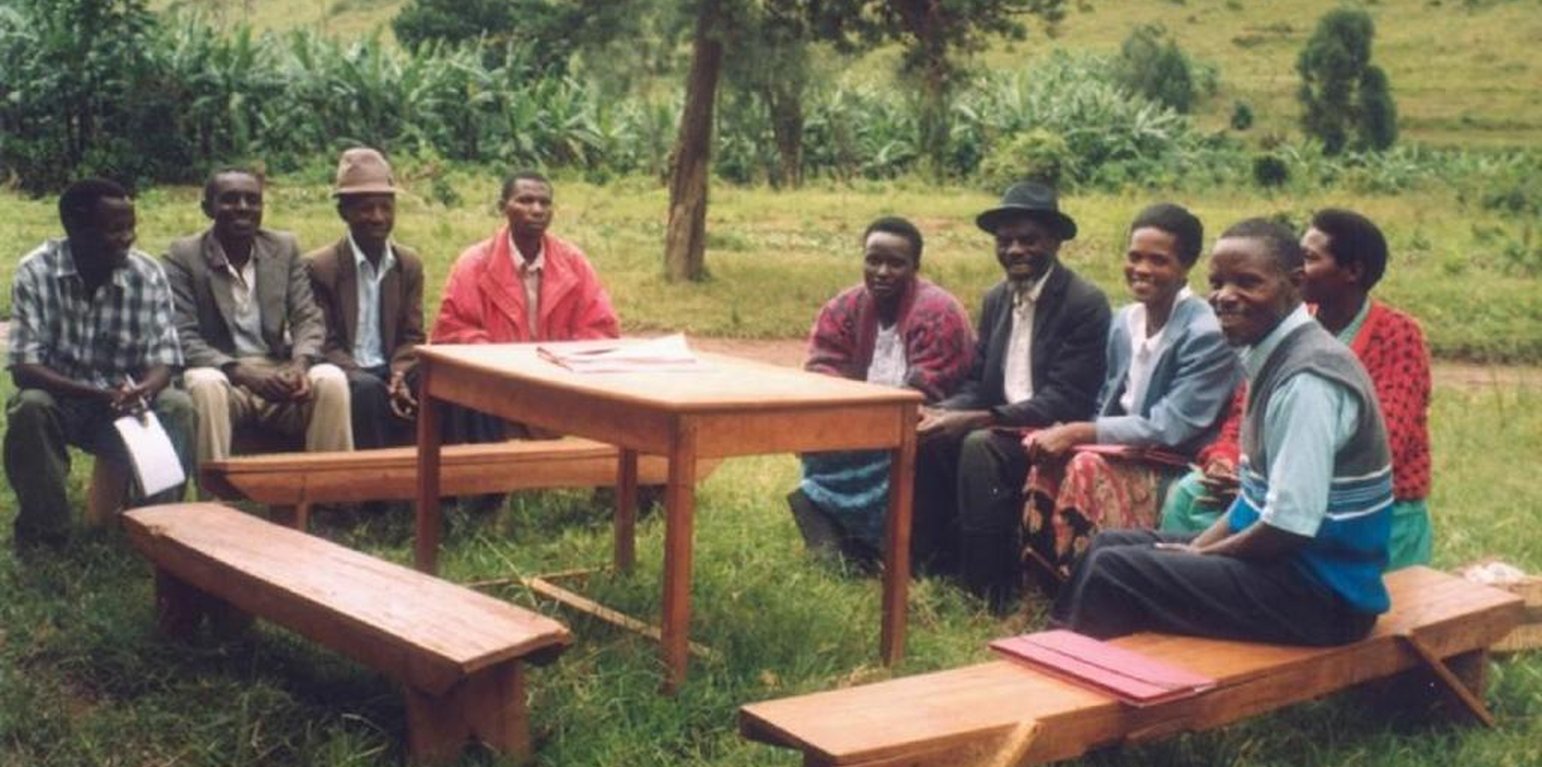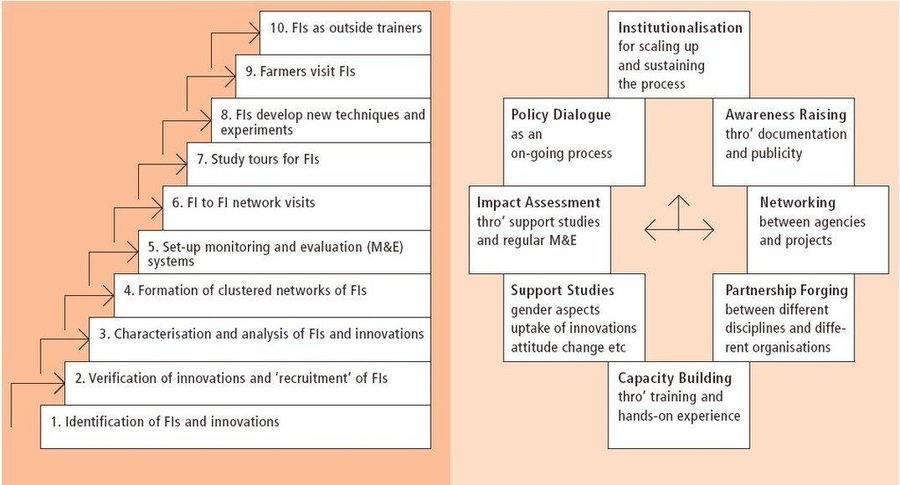Promoting farmer innovation
(Uganda)
Descrição
Identification of farmer innovators in SWC and water harvesting, and using them as focal points for visits from other farmers to spread the practices and stimulate the process of innovation.
Aims / objectives: The Promoting Farmer Innovation (PFI) approach seeks to build on technical initiatives - innovations in the local context - developed by farmers themselves in dry/marginal areas where the conventional approach of transfer of technology from research to extension agents, and then on to farmers, has so often failed. The approach basically comprises identifying, validating and documenting local innovations/initiatives. Simple monitoring and evaluation systems are set up amongst those innovative farmers who are willing to co-operate. Through contact with researchers, extra value is added to these techniques where possible. Farmer innovators are brought together to share ideas. Finally, best-bet technologies, in other words those that are considered to be good enough to be shared, are disseminated through farmer-to-farmer extension. This takes two forms. First, farmers are brought to visit the innovators in their farms. Secondly farmer innovators are used as teachers/trainers to visit groups of farmers - including FAOs farmer field schools in some cases. Only in this second form of extension is an allowance payable to the innovator. A ten-step field activity methodology has been developed.
Methods: At programme level, there is capacity building of in-line extension and research staff, who are the main outside actors in the programme. In each of the countries the project has been implemented through a government ministry, which partners various NGOs in the field. The principle, and practice, is not to create separate project enclaves, but to work through existing personnel, sharing buildings and vehicles that are already operational in the area. A programme development process methodological framework shows how the ultimate goal of institutionalisation can be achieved. PFIs first phase, completed in 2000, was financed by the Government of The Netherlands, through UNDP, and was active in Kenya, Tanzania and Uganda.
Localização
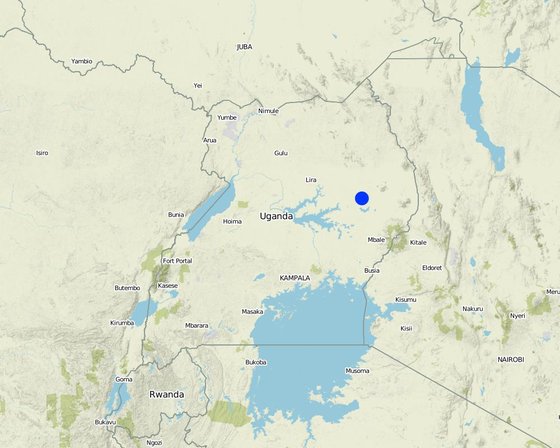
Localização: East Africa (parts of Kenya, Tanzania and Uganda), Uganda
Geo-referência de locais selecionados
Data de início: 1996
Ano de término: 2000
Tipo de abordagem
-
Tradicional/Indígena
-
Iniciativa/inovação local recente
-
Baseado em projeto/programa
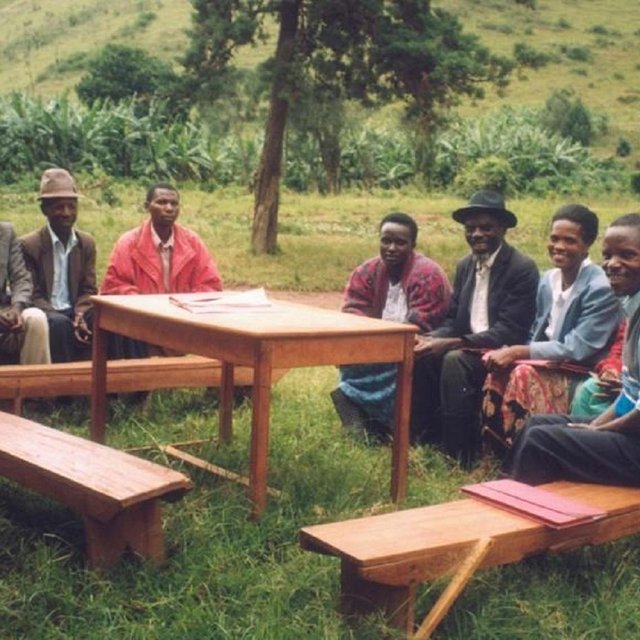
A cluster of innovators in Kabale District, Uganda, with the national coordinator, Alex Lwakuba (far left).
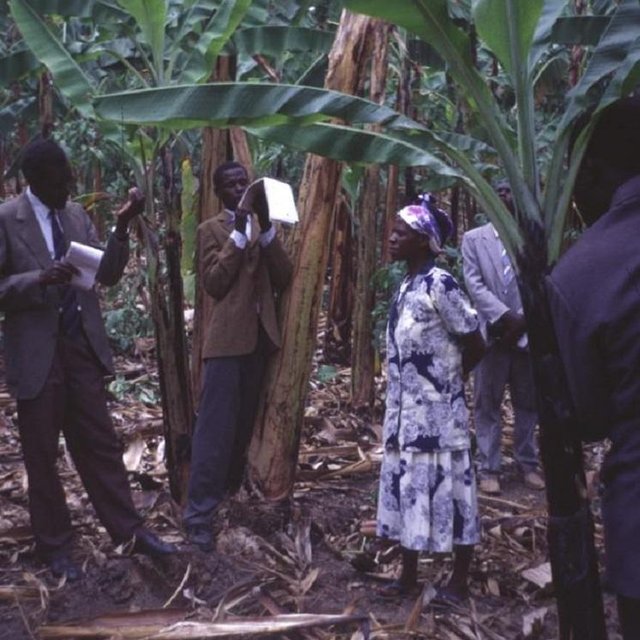
Farmer-to-farmer extension: a female innovator shares her skills.
Objetivos de aproximação e ambiente propício
Principais metas / objetivos da abordagem
The Approach focused mainly on SLM with other activities (Better land husbandry practices (eg composting, crop selection))
Improve rural livelihoods through an increase in the rate of diffusion of appropriate SWC/water harvesting technologies based on farmer innovation, and through farmer-to-farmer exchange visits. At a higher level: to demonstrate the effectiveness of such an approach so that it can be institutionalised.
The SLM Approach addressed the following problems: - poor supply of relevant recommendations from research for small scale farmers in marginal areas - poor delivery of SWC technologies (where they exist) to farmers - lack of motivation of research and extension staff - isolation of promising ???innovative??? SWC/water harvesting ideas which address low crop yields, land degradation and poverty - lack of exchange of this knowledge
Condições que permitem a implementação da Tecnologia(s) aplicada(s) sob a Abordagem
Condições que dificultam a implementação da Tecnologia(s) aplicada(s) sob a Abordagem
-
Normas e valores sociais/culturais/religiosos: Favoured farmer syndrome: where too much attention is given to particular innovative farmers and jealousy is aroused in others
Treatment through the SLM Approach: Avoid working with innovators who are so exceptional that they are outside society and others cannot relate to them. Rotate the farmers who are used as learning points: in other words once another farmer has adopted the technology, use him or her as the focal point.
-
Disponibilidade/acesso a recursos e serviços financeiros: Danger of identifying innovations that are good technically but too expensive for ordinary farmers to implement.
Treatment through the SLM Approach: Linked to point (1) above: beware of farmers who are too exceptional/too rich.
-
Quadro institucional: Lack of motivation of research and extension institutions
Treatment through the SLM Approach: Bringing them together with farmer innovatiors
-
Quadro jurídico (posse de terra, direitos de uso da terra e da água): Who gets the credit for the particular innovation?
Treatment through the SLM Approach: Important to make sure that an innovation is traced back within the locality to its roots, identifying the 'owner'. Especially important when a name is attached to an innovation.
The existing land ownership, land use rights / water rights hindered a little the approach implementation Farmers will only invest time and effort in innovation when they have secure land use rights (though not necessarily ownership), which is the case in all the areas where PFI has been operational. Access to land for women was a problem which inhibits women innovating.
-
Outro: Cultural: Gender imbalance in identification of innovators: women overlooked
Treatment through the SLM Approach: Gender sensitisation and training: bring together the identifiers with the farmers - male and female.
Participação e papel das partes interessadas envolvidas
Partes interessadas envolvidas na abordagem e seus papéis
| Que partes interessadas/órgãos de implementação estavam envolvidos na abordagem? |
Especifique as partes interessadas |
Descreva o papel das partes interessadas |
| Usuários de terra/comunidades locais |
|
|
| Especialistas em GST/ consultor agrícola |
|
|
| Organização não governamental |
|
All involved et different levels: after implementation mainly government and NGO |
| Governo nacional (planejadores, responsáveis pelas decisões) |
|
All involved et different levels: after implementation mainly government and NGO |
| Organização internacional |
|
All involved et different levels: after implementation mainly government and NGO |
Agência líder
International specialists in collaboration with/after discussions with national specialists and land users
Envolvimento do usuários de terra/comunidades locais nas diferentes fases da abordagem
Nenhum
Passivo
Apoio externo
Participativo
Automobilização
Iniciação/motivação
public meetings, interviews/questionnaires, workshops/seminars, rapid/participatory rural appraisal; interviews/Participatory Rural Appraisals etc
Planejamento
rapid/participatory rural appraisal, interviews/questionnaires, public meetings, workshops/seminars; interviews/Participatory Rural Appraisals etc
Implementação
Mainly: farmer-to-farmer exchange, responsibility for minor steps; partly: responsibility for major steps; interviews/Participatory Rural Appraisals etc
Monitoramento/avaliação
Mainly: public meetings, measurements/observations; partly: workshop/seminars; monitoring, using forms designed mainly by specialists
Fluxograma
Farmer innovation methodology left: Field activities: the ten steps– from identification through to using innovators as trainers. (Critchley, 2000) right: Programme development processes: the framew
Tomada de decisão sobre a seleção da Tecnologia GST
As decisões foram tomadas por
-
Somente usuários da terra (iniciativa própria)
-
Principalmente usuários da terra, apoiados por especialistas em GST
-
todos os atores relevantes, como parte de uma abordagem participativa
-
Principalmente especialistas em GST, após consulta com usuários da terra
-
Somente especialistas em GST
-
Políticos/líderes
As decisões foram tomadas com base em
-
Avaliação de conhecimento bem documentado de GST (tomada de decisão baseada em evidências)
-
Resultados de pesquisa
-
Experiência pessoal e opiniões (não documentado)
Suporte técnico, reforço das capacidades e gestão do conhecimento
As seguintes atividades ou serviços têm sido parte da abordagem
-
Reforço das capacidades/ formação
-
Serviço de consultoria
-
Fortalecimento da instituição (desenvolvimento organizacional)
-
Monitoramento e avaliação
-
Pesquisa
Reforço das capacidades/formação
Foi fornecido treinamento às seguintes partes interessadas
-
Usuários de terra
-
Equipe de campo/consultores
-
SWC specialists, extensionists/trainers
Tipo de formação
-
Em exercício
-
Agricultor para agricultor
-
Áreas de demonstração
-
Reuniões públicas
-
Cursos
-
farm visits
Assuntos abordados
Staff seconded from Ministries of Agriculture/NGOs provide: (1) methodology training for participating staff (2) presentational skill training for farmer innovators and (3) training in gender aspects.
Serviço de consultoria
Foi prestado um serviço de consultoria
-
nas áreas dos usuários da terra
-
Em centros permanentes
Name of method used for advisory service: Farmer innovator approach; Key elements: There are new roles for government/NGO extension staff under this methodology - as trainers and faci, Identify farmer innovators, form networks of farmer innovators, which meet, Bring farmers to se 'best bet' innovations; 1) Advisory service was carried out through: government's existing extension system, non-governmental agency; Extension staff: mainly government employees 3) Target groups for extension: land users
Advisory service is quite adequate to ensure the continuation of land conservation activities
Fortalecimento institucional
As instituições foram fortalecidas / estabelecidas
-
Não
-
Sim, pouco
-
Sim, moderadamente
-
Sim, significativamente
Descreva instituição, papéis e responsabilidades, membros, etc.
Tipo de apoio
-
Financeiro
-
Reforço das capacidades/ formação
-
Equipamento
Mais detalhes
training (see also Annex A3)
Monitoramento e avaliação
bio-physical aspects were regular monitored by 0 through observations; indicators: soils, moisture
technical aspects were regular monitored by 0 through observations; indicators: inputs
socio-cultural aspects were ad hoc monitored by 0 through measurements; indicators: number of men/women participating
economic / production aspects were regular monitored by 0 through observations; indicators: yields
area treated aspects were ad hoc monitored by 0 through observations; indicators: None
no. of land users involved aspects were ad hoc monitored by 0 through observations; indicators: None
There were few changes in the Approach as a result of monitoring and evaluation: Some changes, for example (a) increased numbers of women identified as innovators in response to gender sensitisation/training and (b) ???rotation??? of farmer innovators used for training - that is not using the same farmers all the time, as this can create envy. E.g. also better integration with government services/system for technical backstopping and extension
Pesquisa
As pesquisas trataram dos seguintes tópicos
-
Sociologia
-
Economia/Marketing
-
Ecologia
-
Tecnologia
-
socio-economics
Theoretically, researchers should respond to the farmers??? research agenda, though this has proved difficult to achieve in practice. Apart from process monitoring of the methodology, which has led to improvements, technical research into the innovations has been relatively weak.
Research was carried out on-farm
Financiamento e apoio material externo
Orçamento anual em USD para o componente GST
-
< 2.000
-
2.000-10.000
-
10.000-100.000
-
100.000-1.000.000
-
> 1.000.000
Precise annual budget: n.a.
Approach costs were met by the following donors: government (national government): 20.0%; international (International agency): 60.0%; local community / land user(s) (-): 20.0%
Os seguintes serviços ou incentivos foram fornecidos aos usuários de terras
-
Apoio financeiro/material concedido aos usuários da terra
-
Subsídios para insumos específicos
-
Crédito
-
Outros incentivos ou instrumentos
Análise de impactos e declarações finais
Impactos da abordagem
Não
Sim, pouco
Sim, moderadamente
Sim, significativamente
A abordagem melhorou as questões de posse de terra/diretos do usuário que inibiam a implementação das tecnologias de GST?
Gender sensitisation training may have helped.
The problem is unlikely to be overcome in the near future.
Principal motivação dos usuários da terra para implementar a GST
Atividades de sustentabilidade de abordagem
Os usuários da terra podem sustentar o que foi implementado através da Abordagem (sem apoio externo)?
Conclusões e experiências adquiridas
Pontos fortes: visão do usuário de terra
Pontos fortes: a visão do/a compilador/a ou de outra pessoa capacitada
-
Builds on local ideas (How to sustain/ enhance this strength: Continue the approach and institutionalise.)
-
Revitalises the extension service (How to sustain/ enhance this strength: Train and make use of existing Government extension agents.)
-
attractive to stakeholders at all levels (How to sustain/ enhance this strength: Involve and inform stakeholders at all levels of plans and progress.)
-
Gives land users more confidence in their own abilities (How to sustain/ enhance this strength: Continue to prioritise farmers and keep them at centre of activities.)
-
Offers new locally tested ideas/technologies which work (How to sustain/ enhance this strength: Keep the focus on the farmers??? initiatives and use participatory technology development processes to improve these technologies.)
Pontos fracos/desvantagens/riscos: visão do usuário de terracomo superar
Pontos fracos/desvantagens/riscos: a visão do/a compilador/a ou de outra pessoa capacitadacomo superar
-
Dependent on individual commitment and flexibility
Training in skills and methodologies.
-
Does not follow the conventional institutional chain of command
Considerable training in skills and methodologies required.
-
Sometime confers too much prestige on a particular group of ???favoured farmers???
Rotate??? farmers who are the focus of attention.
-
Researchers reluctant to respond to farmers??? agenda
Effort needed to convince research staff of the need for, and potential benefits from, joint Critchley WRS (2000) Inquiry, Initiatives and Inventiveness: Farmer Innovators in East Africa. Phs Chem Earth (B), Vol 25, no 3, pp 285??¡§288Critchley WRS (2000) Inquiry, Initiatives and Inventiveness: Farmer Innovators in East Africa. Phs Chem Earth (B), Vol 25, no 3, pp 285??¡§288Critchley WRS (2000) Inquiry, Initiatives and Inventiveness: Farmer Innovators in East Africa. Phs Chem Earth (B), Vol 25, no 3, pp 285??¡§288Critchley WRS (2000) Inquiry, Initiatives and Inventiveness: Farmer Innovators in East Africa. Phs Chem Earth (B), Vol 25, no 3, pp 285??¡§288research with farmers.
Referências
Revisor
-
Fabian Ottiger
-
Deborah Niggli
Data da documentação: 12 de Janeiro de 2009
Última atualização: 4 de Abril de 2018
Pessoas capacitadas
-
Kithinji Mutunga (kithinji.mutunga@fao.org) - Especialista em GST
-
William Critchley (williamcritchley01@gmail.com) - Especialista em GST
Descrição completa no banco de dados do WOCAT
A documentação foi facilitada por
Instituição
- CIS-Centre for International Cooperation (CIS-Centre for International Cooperation) - Países Baixos
- Food and Agriculture Organization of the United Nations (FAO) - Itália
- Ministry of Agriculture and Livestock Development of Kenya (MoA) - Quênia
Projeto
- Book project: where the land is greener - Case Studies and Analysis of Soil and Water Conservation Initiatives Worldwide (where the land is greener)
Referências-chave
-
Critchley WRS (2000) Inquiry, Initiatives and Inventiveness: Farmer Innovators in East Africa. Phs Chem Earth (B), Vol 25, no 3,Mutunga K and Critchley W (2001) Farmers??? initiatives in land husbandry. Regional Land Management Unit, Nairobi, KenyaCritchley W and Mutunga K (2003) Local innovation in a global context: documenting farmer initiatives in land husbandry through WOCAT.Critchley et al. (1999). Promoting farmer innovationPromoting farmer innovation VIDEO: RELMA, Nairobi (cost free)RELMA, Nairobi (cost free)
-
Mutunga K and Critchley W (2001) Farmers initiatives in land husbandry. Regional Land Management Unit, Nairobi, Kenya:
-
Critchley W and Mutunga K (2003) Local innovation in a global context: documenting farmer initiatives in land husbandry through WOCAT.:
-
Critchley et al. (1999). Promoting farmer innovation: RELMA, Nairobi (cost free)
-
Promoting farmer innovation VIDEO: RELMA, Nairobi (cost free)
